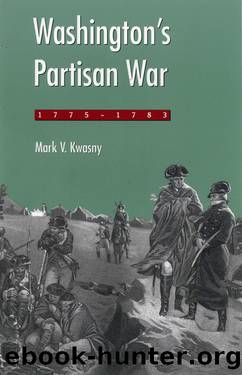Washington's Partisan War, 1775-1783 by Mark Kwasny

Author:Mark Kwasny [Kwasny, Mark]
Language: eng
Format: epub
Tags: Biography & Autobiography, Presidents & Heads of State, History, Military, United States, Revolutionary Period (1775-1800)
ISBN: 9781631010040
Google: dLCiAQAACAAJ
Publisher: Kent State University Press
Published: 2014-01-05T04:12:42+00:00
On June 1, the British at Stony Point opened a battery and shelled the American fort across the river on Verplankâs Point. After one shell exploded in the fort and killed three of the defenders, the Americans evacuated the fort and ran right into General Vaughanâs column, which was advancing from Tallerâs Point. Forced back into the fort, the garrison of seventy-four men quickly surrendered to Vaughanâs party. Altogether, in the operations on both sides of the river, the British had only one casualty.33
As the British captured Stony Point and Verplankâs Point, Washington urged McDougall to concentrate his forces around the Highland forts and apply to the governments of New York and Connecticut for even more militia if necessary. He advised Governor Livingston to be prepared to call out New Jerseyâs militia should the Hudson River attacks prove to be a feint to draw men out of New Jersey. Washington had already ordered the three Continental divisions stationed in New Jersey to march to New York. At that time, McDougall had six Continental brigades on hand in the Highlands. The New York militia meanwhile began to collect, and Governor Clinton arrived at Fishkill to take personal command on the east side of the river.34
After the relatively easy capture of the two forts, the British commander halted further operations. Sir Henry Clinton had hoped that Washington would concentrate his army and fight for the forts, but since the rebel chief continued to avoid a battle, Clinton began fortifying the two points. Without reinforcements, he believed a further advance up the river to be too dangerous. Washington meanwhile frustrated Clinton by keeping his divisions well away from the British positions. He stopped the main portion of the army, on its way from New Jersey, at Smithâs Cove, about ten miles from Stony Point. McDougall held West Point with about seventeen hundred men, but the rest of his division stayed on the east side of the Hudson about nine miles south of Fishkill. Governor Clinton and the New York militia from the east side of the river remained with McDougall, and six hundred militiamen guarded the roads on the west side that led from Stony Point to West Point. The governor promised to support any militia units that took positions near the British posts and skirmished with them. Farther east, one-fourth of the Connecticut militia units from the counties west of the Connecticut River had orders to march to New York, and in early June the first contingent of these soldiers began to collect at Fredericksburgh, New York.35
On June 5, Washington began detaching small Continental parties from the nearby divisions to cooperate directly with the militia forces operating near the British posts along the river. He hoped that the Continentals would encourage the militia in the field to be active. He also warned the Continental generals to be careful not to attack friendly forces by mistake, since small militia parties were out on many of the roads. He wanted to avoid an unfortunate clash between friends.
Download
This site does not store any files on its server. We only index and link to content provided by other sites. Please contact the content providers to delete copyright contents if any and email us, we'll remove relevant links or contents immediately.
Harry Potter and the Goblet Of Fire by J.K. Rowling(3023)
Unfinished: A Memoir by Priyanka Chopra Jonas(2911)
Never by Ken Follett(2869)
The Man Who Died Twice by Richard Osman(2289)
Machine Learning at Scale with H2O by Gregory Keys | David Whiting(2263)
Fairy Tale by Stephen King(2058)
Will by Will Smith(2032)
Rationality by Steven Pinker(1759)
The Storyteller by Dave Grohl(1655)
The Dawn of Everything: A New History of Humanity by David Graeber & David Wengrow(1564)
The Dark Hours by Michael Connelly(1562)
The Stranger in the Lifeboat by Mitch Albom(1527)
Cloud Cuckoo Land by Anthony Doerr(1428)
The Becoming by Nora Roberts(1323)
Friends, Lovers, and the Big Terrible Thing by Matthew Perry(1321)
Crying in H Mart by Michelle Zauner(1312)
Einstein: His Life and Universe by Walter Isaacson(1311)
New Morning Mercies: A Daily Gospel Devotional by Paul David Tripp(1299)
A Short History of War by Jeremy Black(1295)
